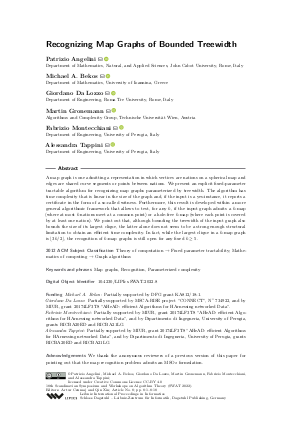@InProceedings{angelini_et_al:LIPIcs.SWAT.2022.8,
author = {Angelini, Patrizio and Bekos, Michael A. and Da Lozzo, Giordano and Gronemann, Martin and Montecchiani, Fabrizio and Tappini, Alessandra},
title = {{Recognizing Map Graphs of Bounded Treewidth}},
booktitle = {18th Scandinavian Symposium and Workshops on Algorithm Theory (SWAT 2022)},
pages = {8:1--8:18},
series = {Leibniz International Proceedings in Informatics (LIPIcs)},
ISBN = {978-3-95977-236-5},
ISSN = {1868-8969},
year = {2022},
volume = {227},
editor = {Czumaj, Artur and Xin, Qin},
publisher = {Schloss Dagstuhl -- Leibniz-Zentrum f{\"u}r Informatik},
address = {Dagstuhl, Germany},
URL = {https://drops.dagstuhl.de/entities/document/10.4230/LIPIcs.SWAT.2022.8},
URN = {urn:nbn:de:0030-drops-161681},
doi = {10.4230/LIPIcs.SWAT.2022.8},
annote = {Keywords: Map graphs, Recognition, Parameterized complexity}
}

 Creative Commons Attribution 4.0 International license
Creative Commons Attribution 4.0 International license


























